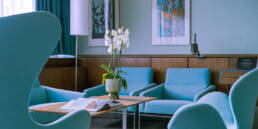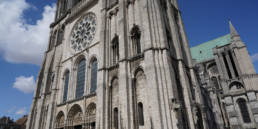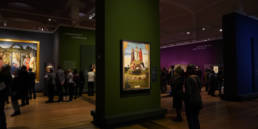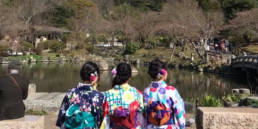People often ask me what I miss about my native Canada. Generally, I say “nothing”: I’m very satisfied with life in Italy, and lack only access to cheddar cheese and litres of good maple syrup, but Italy’s food makes up for that on most days. But on a recent trip glamping in Slovenia, I realized I am a little homesick for one thing I hold dear from my Canadian childhood: freshwater swimming in an uncrowded, natural environment.

At BigBerry, on the Kolpa River that borders with Croatia, I had a bit of a flashback to happy times camping or cottaging in Northern Ontario. While I can’t declare Slovenia “Europe’s Canada” — for one, it’s already got the epithet “Switzerland of the Balkans”, plus the country is just tiny, literally the size of the Greater Toronto Area where I grew up, and with less than a third of that city’s population — I can say that there are some happy overlaps. But the country’s got its own charm, making it a perfect balance between nature and culture, and a brilliant place for a visit – as I found out.
I admit, I wouldn’t have thought of visiting Slovenia had I not received an invitation to stay at BigBerry, which dubs itself as a “luxury lifestyle camp”. The brand new resort opened this year to press, and next year to the public, and promised visits to local producers and cultural sites from their home base on the bed of the Kolpa River. The camp’s activity calendar, with canoeing and crafts, immediately had me thinking of the summer camp I attended in Canada, which constituted a character-building form of rusticity that I have banned in adulthood in favour of 5-star hotels. When I saw that the 6 private cabins on the river had air conditioning and individual hot-tubs, however, I signed right up.

Now is the time to admit my ignorance: we had to do a little catching up on Balkan geography and political history on the drive over, because when I was in school, this was Yugoslavia. Before the first world war, this area was part of the Austro-Hungarian Empire, while in 1992 the individual states proclaimed independence from the then-socialist-federal-republic. Modern day Slovenia borders on Austria and Italy in the attractive mountainous north, Croatia in the south and a little bit of Hungary in the east. With some 66% of the country covered in forests (according to a 2005 report of the Forest Service of Slovenia), it’s the third greenest country in the EU, earning it yet another epithet: The Green Country.
Ever since encountering it at the Slovenian pavilion at Expo 2016 in Milan, I’ve been more aware of the country’s slogan, “I Feel Slovenia” – heavily promoted on the back of buses in Florence. The country is committed to “going forward with nature… focusing on organic development, promoting a niche economy, welcoming diversity and attracting the best technological and human potential.” They say that “Slovenia cannot be presented with a simple image, we have to feel and sense Slovenia – with words, sounds, colours, touch, actions and experience.” (source) The modern brand, presented on an appropriately young green background, really does encompass the Slovenian experience. This is not a country with a series of historical must-sees (like neighbouring Italy), but rather one to be experienced through its diversity and through encounter with its inhabitants. In this, the BigBerry experience is right in line with what the country wants to promote.

As we literally drove across the whole country arriving to BigBerry from Florence, we spotted top tourist attraction Škocjan caves, a UNESCO Heritage site that contains the largest known underground canyon in the world. We passed by Ljubljana, and I said “too bad we won’t get to visit” since we just had a few days. Little did I realize that everything is pretty close by: although BigBerry is accessed through a very green road that winds through woods and small towns, the next day we took a day-trip to the capital, just an hour and fifteen minutes’ drive from camp.
Easygoing Ljubljana

Ljubljana is the capital city, with some 300k inhabitants and a university, but you’d never know it – on a summer’s day, streets were pleasantly uncrowded, and stunningly clean. Coming over from chaotically crowded and perennially filthy Florence, these two refreshing facts suddenly hit me as I realized I felt unstressed and happy there. (Apparently it’s also very safe.) The city’s clear layout and infrastructure is due to its modern construction: hit by an earthquake on Easter Sunday of 1895, it was entirely rebuilt in subsequent decades, leaving only the shell of its castle, from which you can view the city below.
Much of the way the city looks can be owed to the architect Jože Plečnik, whose earlier works are in the Art Nouveau style (in this neck of the woods it’s called Seccession like in Vienna, and in fact he worked in Vienna and Prague); in the 1930s, he innovated stylistically with the more modern, block-like National University Library, built from the ruins of the old library and whose reading room beautifully integrates furniture with an architecture in a way that recalls Michelangelo’s Laurentian Library.

The city’s main square is accessed by three iconic bridges designed in 1929 by the same Plečnik, a solution that was cheaper than expanding the older single bridge when car traffic became heavy in the 1920s. The square itself is dedicated to a poet, France Prešeren (whose statue shows him inspired by a nude muse that offended members of the church across the square), while the city’s dedication to the arts continues to be made manifest nearby with the facade of the university music faculty that displays busts of its many composers and musicians.

Like any cold-weather country, Slovenians really come out as soon as it gets warm enough. Ljubljana’s pedestrian-only historical center (with an adorable on-call, free electric bus service) is lined with bustling sidewalk cafés. In the summertime, every Friday there’s a street food festival that is packed from noon to midnight. The vibe is chill, green and modern.
The Slovenia of the Future
Outside of the “big city”, most of my exploration was closer to “home” in the country’s south-eastern corner, a rather isolated region called Bela Krajina. When I encountered some bloggers from Ljubljana, they said they’d never been here (despite the apparent proximity) and never really considered this area as a place to visit. Indeed, its mostly agricultural industry and the peoples’ odd habit of decorating Easter-eggs year-round doesn’t necessarily beckon a visit. There are no must-sees here, other than the Kolpa River (more on that later). But that is what makes it appealing: smack in the middle of Europe, there’s an area that still maintains a feeling of isolation, while actually being both connected and forward-looking.

The brilliance of the people in this area shines when you get a look into some of the cottage industries they have built up, either from tradition, or through innovation. For example, we visited the honey bee farm of a jovial man named Cebelarstvo Veselič in Metlika. His home and small wooded property – with neighbours not far off – is also where he raises bees… 30 million of them, to be exact. The property is planted with various trees and bushes to attract and feed the buzzing beasts, who then deposit the goods in an assortment of hive types – ranging from the traditional Slovenian protected hut to the new pan-European style self-standing boxes. A normal production for each bee family (and he has 300) is 20 to 50 kilos every three weeks, but he tells us that this year’s cold Spring caused sluggish, hungry bees who are now producing only 50-70% less than usual, so it’s not going to be a good year. A third generation beekeeper, Veselič hopes that his three sons will carry on the family business, and mentions to our cute blonde American companion that he’s looking for a wife for them. She politely declines. Beekeeping is a strong tradition here in Bela Krajina, it seems, since everywhere we go, there’s information about it.
[The video below is a somewhat silly “movie trailer” I made here]
We also encountered a less traditional family business at the home of Martin Pečarič. Back in 1937, when kerosene was in short supply, his ancestors realized they could extract oil out of the walnuts that grew on trees on their property. More recently, he expanded his family’s oil mill business to a much wider line of unusual oils. He says he realized he had make a niche product, and do it well, because his property is quite small. He traveled to then-East-Germany to purchase the know-how required to make a highly efficient cold press that, once he finally perfected it, is able to extract 100% of just about anything. Now he makes oil out of pumpkin, hemp, sesame, poppy seeds, even grape seeds, and he’s learned all their properties – and created a market for himself – through contact with local doctors, thanks to his day-job as an ambulance driver. The fit and built 50-something Pečarič is his own best consumer. He tells us with pride about his own diet and habits, including apricot seed oil massages, using sesame oil for suntanning (apparently SPF is not a concern), and lowering his blood-sugar with black cumin oil. With their packaging in line with the latest trends in luxury oils, this stuff could easily go for $25 a bottle at Whole Foods (but is sold only locally).

The Slovenian wine industry is also experiencing renewal, as local producers are starting to take up a centuries-long tradition that was abandoned under Communist rule. In Bela Krajina, the wine we tasted from Malnarič was a solid table wine, in line with any mass-market Italian wine, though the New York Times reports that there are some spectacular vintages available – if you can get your hands on them outside of Slovenia, which may be difficult.

Tourism, is, no doubt, an industry of the future for Slovenia, and BigBerry steps in here with an innovative solution. The resort is actually the extension and flagship of a company called Hosekra that manufactures pre-fab design homes. It’s the first in what will be a franchised group of holiday homes around Europe – interested owners of camping grounds will get not only the attractive buildings, but also the marketing and communication services that come with this friendly brand. The homes themselves are very cute, mixing comfort and facilities with space-saving design; combined with the location and personnel, the flagship resort on the Kolpa river bodes well for the future of this Slovenian company.
The Slovenia of the Past
In the best of cases, one business helps another. BigBerry seems to be doing a lot to create a network of forward-thinking businesses in the small area of Bela Krajina, where they will regularly bring guests to experience the best of local products, but also to learn about local culture.

The government is doing a lot to encourage preservation efforts in Slovenia, where everything “green” is promoted (and likely funded). The Kolpa River is one of the country’s prettiest, cleanest and warmest bodies of water, and at least for a stretch of it, it’s preserved as part of a natural park. (That’s great news for its many species of fish, as long as they stay on the Slovenian side of the border…) We visited the Kolpa Natural Park center in a 300-year-old farm building, which is “animated” by a couple who ardently wishes to protect the river’s nature, and the traditions of the people who have lived along it for centuries.

We started our early morning visit with some Pogača, which sounds a lot like the Italian word focaccia and is a similar flat bread, soft, risen and usually with rosemary on top. Delicious, to be washed down with schnaps at 9:30am, apparently. In fact, this bread is typical of the Bela Krajina area and other winemaking regions because it is well known that it helps absorb the alcohol!

In the courtyard, which would have housed animals and been a working area of this farm that housed an extended family, we learned about how these families were self-sufficient in the creation of flax fibre to weave their own clothes. It was amazing to see the stiff reeds be literally whipped into fibre, and then spun into thread.

The resulting natural-coloured cloth is very durable, and the more you wash it, the whiter it becomes. In fact, according to one legend, the area’s name “Bela Krajina” means beautiful white dots, or white people, because of how they looked when seen from a distance in the fields. Items made with hemp and flax in the natural, ancient way are traditional in the area, you’ll find examples from local craftsmen that BigBerry can recommend.
Glamping in Slovenia
My stay in Slovenia was hardly enough to capture the whole country, but I do feel that, thanks to my hosts, I felt something of the essence that the IFeelSlovenia campaign wishes to communicate. The experience of glamping in Slovenia at BigBerry is really in line with nature, and permits you to be as close as possible to wonders like the Kolpa River.

At the same time, I enjoyed the company of other guests and staff — like-minded world travelers — and of the locals we were privileged to meet. The Canadian in me rejoiced in pre-breakfast swims just a few meters from my air-conditioned cabin before attacking the local products delivered each morning in a cute basket (more pogača!). The city dweller in me was thrilled to find herself in a place where you can go out at night and still see the stars. This is the perfect summer camp for big kids who love nature, culture, good food, good company, and comfortable luxury.

Visitor information
To stay in comfortable wilderness:
BigBerry.eu
Primostek 50 – Gradak – SloveniaFor information
Disclaimer: I was hosted by BigBerry, but all experiences and opinions in this article are my own
Sign up to receive future blog posts by email
Alexandra Korey
Alexandra Korey aka @arttrav on social media, is a Florence-based writer and digital consultant. Her blog, ArtTrav has been online since 2004.
Related Posts
September 18, 2019
Re-Discovering Chartres: the Gothic Cathedral and Beyond
March 31, 2019
Mantegna and Bellini – Berlin exhibition review
May 1, 2018




